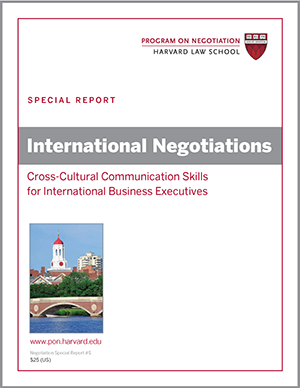
Cross-cultural differences in negotiation can be particularly challenging. When people from different cultures negotiate, they often feel uncertain about how to act and confused by one another’s statements and behavior. The potential for misunderstandings and conflict is often high as a result. In her book, Rule Makers, Rule Breakers: How Tight and Loose Cultures Wire Our World (Scribner, 2018), University of Maryland psychologist Michele Gelfand explains how a simple yet powerful cultural framework can help us make sense of our differences, get along better, and achieve more at the bargaining table.
The tight-loose divide when unlocking cultural differences in negotiation
Scientists and pundits have come up with many theories to explain cross-cultural differences and conflicts at the national and local level: collectivism versus individualism, urban versus rural, red versus blue, and so on. Although these frameworks have proven useful, Gelfand has identified a primal difference that can be applied to virtually all cultures throughout human history: their relative tightness or looseness, as reflected in the strength of their social norms.
The “invisible glue” that holds cultures together, social norms are the behaviors a culture deems acceptable, ranging from whether it’s OK to be late for meetings to how close we should stand to our colleagues to which drugs can be legally consumed. From earliest childhood, we begin to absorb the norms of our culture and often adhere to them unthinkingly throughout our lives.
Although all cultures have social norms, the relative “tightness” of these norms—and the sanctions people face for breaking them—varies widely across cultures, Gelfand and her colleagues discovered in a groundbreaking survey of approximately 7,000 people from more than 30 countries. In relatively “tight” cultures such as Japan, India, and Turkey, people face strict norms regarding everything from littering to punctuality to playing loud music. In “loose” nations such as the United States, Brazil, and the Netherlands, a broader range of behavior is deemed socially acceptable. Although countries can be found on all points of the tight-loose continuum, Asian, Middle Eastern, and Nordic and Germanic European nations tend to be tighter, while English-speaking, Latin, and Eastern European cultures are often looser.
The relative tightness of one’s home culture affects our thoughts and behaviors, including our negotiating style. Speaking broadly, people from the tightest cultures tend to be rule followers. On average, they are more punctual, self-controlled, and disciplined than people from loose cultures. At the same time, they tend to be less open to new ideas and outsiders, and to feel uncomfortable with change. By comparison, people from loose cultures are more likely to break (or at least question) the rules. This can lead them to take ethical shortcuts, but it can also make them more creative and open to new ideas and cultures, as well as more receptive to outsiders. Members of loose cultures also tend to be more willing to change and take risks than those from tight cultures, but they may be a bit unorganized.
Why do cultures evolve to become tight or loose? In her research, Gelfand has found that when a nation faces extreme threats to its existence, such as natural disasters, invasions, and disease outbreaks, it seeks to “create order in the face of chaos” by strengthening rules, laws, and sanctions for noncompliance. Countries often “tighten up” security following terrorist attacks, for instance. By contrast, nations that face fewer external threats have the luxury of remaining loose—more open, less organized. Studying anthropological data, Gelfand and her colleagues found evidence of tight-loose differences in traditional cultures, such as the (tight) Inca in South America and the (loose) Copper Inuit in Canada, suggesting that this powerful distinction has been present throughout human history.
Beyond nations, the tightness-looseness divide applies to virtually all cultures. U.S. states can be categorized as tight (Alabama, Montana), loose (California, New York), or somewhere in between (Minnesota, Delaware), for example. Professions can be tight or loose as well. Members of creative fields, including artists and entrepreneurs, tend to exhibit looser mindsets and behaviors than those who work in fields in which disorder would pose a significant threat, such as manufacturing or banking. In addition, working-class individuals tend to lean toward tightness, reflecting the greater threats to financial and personal well-being they encounter throughout their lives, while members of the upper class, facing fewer such threats, can afford to lean loose.
Bridging cultural differences in negotiation
When we understand why some cultures are tighter and others looser, we have a new tool for decoding cross-cultural negotiations. The following three guidelines will help you assess your counterparts’ behavior more comprehensively, recognize your own tendencies, and reach better results.
1. Improve your “cultural intelligence.” In their research, Gelfand found that people who scored higher on “cultural intelligence,” a measure of one’s ability to adapt to culturally diverse situations, performed better on a negotiation task due to their greater cooperativeness and curiosity, as compared to those who scored lower on cultural intelligence. These results suggest that the more you know about your negotiating counterpart’s culture, the better prepared you will be to claim and create value at the table. In particular, take time to consider whether each of you (or your teams) comes from tight or loose cultures. This analysis will help you anticipate areas where you might complement one another or clash. At the bargaining table, many tight-loose traits, such as willingness to trust, punctuality, and creativity, are likely to emerge. Keep an eye out for these differences, and strive for “cultural empathy.” There are compelling reasons why cultures evolved the way they have, reasons that can help you better understand perplexing behavior.
Take the case of the American film negotiators struggling to make sense of the negotiating behavior of their Chinese counterparts. The U.S. negotiators come from a loose industry (film) within a loose nation. Meanwhile, the Chinese negotiators represent not only a tight nation but now also a very tight entity within that culture: the Communist Party and its censorship system. Indeed, as the renegotiation has unfolded, the Chinese side has demonstrated a classic “tight” mindset and behaviors, including distrust of outsiders and a formal, disciplined approach. We don’t know how the Chinese negotiators perceive the American delegation, but it wouldn’t be surprising if they viewed them as impatient, informal, overly trusting, and disorganized.
2. Look beyond nationality. Remember that a negotiator’s home country is just one culture to which he or she belongs. Other cultures that may exert a tight-loose influence on a negotiator (including you) may include the person’s region, town, profession, and social class. For this reason, be careful about reading too much into nationality alone. Imagine an entrepreneur from a tight country who is creative but evasive, or a military officer from a loose country who is meticulous about following protocol but open and gregarious. Gain insights into your fellow negotiators by thinking broadly about the various groups they represent.
3. Adapt to the other side’s social norms. When we understand the logic behind behaviors that might otherwise seem foreign and frustrating, we become more collaborative and effective negotiators.
To take one example, Gelfand’s research shows that Americans tend to be more impatient than negotiators from some Middle Eastern and Asian nations. Americans often tend to want to quickly get down to business—and become annoyed when negotiators from tighter cultures want to spend lots of time building rapport. This cultural difference makes sense when viewed through the tight-loose lens. Negotiators from tight cultures that have weak legal institutions and suffer frequent external threats would naturally be warier of trusting new negotiating partners. By contrast, citizens of the relatively loose United States may be quicker to trust, as they may assume courts will protect them if their trust is violated.
This type of cultural insight can make us more tolerant of our counterparts’ “flaws”—and perhaps more aware of some of our own. In fact, for example, the more impatient U.S. negotiators are, the worse their financial outcomes, Gelfand has found in her research. When Americans adapt to the slower pace of counterparts from tighter cultures, they are likely to make fewer concessions, while also building stronger relationships with their counterparts. That’s a win-win that translates into any language.
Culture clashes in M&A deals
The 1998 merger of German automaker Daimler-Benz and the American Chrysler Corporation at first seemed like a match made in heaven, but the honeymoon wore off as the two cultures that made up DaimlerChrysler began to clash, writes Michele Gelfand in Rule Makers, Rule Breakers: How Tight and Loose Cultures Wire Our World. The Americans’ informal behavior, such as their habit of using first names rather than titles, made their German counterparts uncomfortable, while the Americans felt constrained by the Germans’ strictly controlled meetings. When the company’s German leaders imposed a top- down, heavily hierarchical structure post-merger and laid off thousands of U.S. workers, trust and morale collapsed, and DaimlerChrysler’s stock price moved steadily downward. In 2007, the Americans and Germans gave up and parted ways.
As the DaimlerChrysler saga illustrates, when negotiating a merger, organizations often neglect to consider their cultural compatibility. Collecting data on more than 6,000 large international M&A (merger and acquisition) deals involving more than 30 countries from 1980–2013, Gelfand and Western University professor Chengguang Li found that the greater the tight-loose cultural gap between two merging companies, the rockier the merger. “These mergers took longer to negotiate and finalize, had lower stock prices following the deal, and yielded much lower returns for the buyer in the deal,” writes Gelfand in Rule Makers, Rule Breakers.
Cross-border mergers can be fruitful, but they need to be conducted with a clear-eyed view of cultural differences. Gelfand advises parties to carefully assess their cultures and negotiate the steps that will be needed to blend them successfully. Loose cultures may need to recognize areas where they should tighten up (through more structure or monitoring, for example), while tight cultures may need to identify domains where they can be more flexible (through the dress code, decision-making processes, etc.).
What other cross-cultural differences in negotiation have you experienced?





